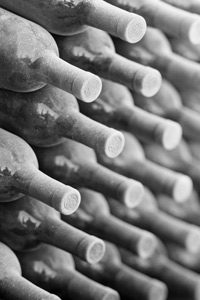One of my most unpleasant wine experiences was with a pinot noir. It was from a very well known and well respected Argentinian producer, and I was at his winery in a gorgeous location not far from Mendoza, known for its experimental cellar-door bottlings. This winemaker makes fantastic malbec wines, and I was excited to try what is a relatively unusual group for the country. But it was barely drinkable – the pinot was at 15.5 percent alcohol, way too much for this most delicate of grapes to handle, and the alcohol had stripped away every bit of fruit.
But that is the thing about pinot. Every great winemaker thinks about producing his own version, because it is a famously maddening, elusive grape to get right. Pinot has been described as, ‘the most romantic of wines, and ‘sex in a glass’ – maybe because for the wine drinker, it offers gorgeous pure fruit flavours with, at its best, a hint of mystery. Now that winter is hitting its stride, for me these are the months that pinot noir really comes into its own. We traditionally think of cold weather as being the best time to reach for big, heavy wines like an Oz shiraz or a Napa cabernet, but personally I think the full heat of summer can match those big, blowsy flavours, while the calm chill of winter is best expressed though the subtle charm of a good pinot.
2005 Beaune, Domaine des Croix 2005 (£18.95)
Creamy red fruits, a sweet edge combined with a lightness of touch make this a real Burgundy find. At only 12.5 percent alcohol, winemaker David Croix shows that pinot thrives at these lower alcohol levels. This may be light, but it is full of flavour, with more strawberry and redcurrant flavours than the full summer attack of some New World pinots. This is the first vintage that David has been making wine at this five-hectare site, and really is a name to watch.
Willamette Valley Estate Pinot 2006 (approx $40)
You get the feeling that you are in the hands of experts here: Willamette Valley is a very accomplished, polished wine that has a real depth of flavour. Alcohol levels reach 14.5 percent but for once in a pinot this amount of alcohol is fully in balance with its fruit and structure. Seductive smoky notes nudge upwards into the damson and fresh plum flavours. Worth knowing also that because of the climate in Willamette Valley, this wine has some of the highest reservatrol levels of any pinot – which means it is rich in a natural antioxidant.
Wild Earth Pinot Noir 2006 (approx £17.99)
A good date wine, as this makes a lovely first impression, with ripe dark fruit flavours and real spice as it opens up. The 14.3 percent alcohol makes it slightly hot on the aftertaste, however, which spoils things just slightly. With a good long meal, this would definitely be a rewarding bottle, and its numerous plaudits (it recently won Best International Pinot at the International Wine Challenge) attest to the many fans of this full-flavoured approach to the grape. The success of this family run winery established by Quintin and Avril Quider in 1998 looks set to grow.
2007 Don Victor, Pinot Noir, William Fevre, Chile (£6.95)
Just had to include this for the fabulous value offered from Chile, brought to you with some Burgundian flair from one of my favourite winemakers (he is more usually found in Chablis than at this winery located 700 metres up in the Maipo Valley). The wine is made in small open tanks in the Burgundy style, with traditional punching down to gently extract the soft red fruit flavours. There is some spice and new oak sweetness, and although it perhaps lacks a little sparkle on the finish, it’s worth seeking out. I would usually steer clear of low-priced pinots, so this was a really pleasant surprise.
Saint Clair Pioneer Block 14 Doctor’s Creek Pinot Noir 2006 (approx €20,00)
Neal and Judy were among the first contract grape growers in Marlborough with first plantings in 1978, and they now make their own wine with winemaker Matt Thomson. This single vineyard pinot from Hawkesbury Road on the southern side of the Omaka Valley is deftly made and very accomplished – with a silky texture that is immediately appealing. Lightly creamy, with plenty of spice to add depth to the fruit, if perhaps a touch too obvious with the new oak. One of my favourite wines of the tasting – and at just 13 percent alcohol, an easy wine to love.
Domaine A Pinot Noir, 2005, Tasmania (approx £29.49)
This 20-hectare estate is located in Cool River Valley in southern Tasmania. The clue is in the name – this region has the fresh temperatures, combined with heat, that pinot noir loves when developing its subtler aromas. The finish of this wine has an almost medicinal, minty flavour that is very appealing, giving real definition to the flavour, and the palate is run through with a sweet, mild smoky cedarwood. At 13.5 percent, it is a light, very elegant wine – and one that disappears fast, as an average year sees just 10,000 bottles.
Markus Molitor, Brauneberger Klostergarten Spatburgunder (Pinot Noir) 2005 (€39.50)
This wonderful German pinot is about to become seriously sought after. Molitor is above all a Riesling man, with just three percent of his vineyards planted to pinot, but he puts this tiny amount to particularly good use in this bottle. The vines themselves are old clones from Gevrey-Chamberin in Burgundy, and he works them using traditional methods, with no selected yeasts, no enzymes and no fining. The wine is then stored for 16 months in new French oak barrels – and then, happily, it is ready to drink. Full-bodied but very elegant, this has fine tannins and a minerality that lifts the palate. Gorgeous.





